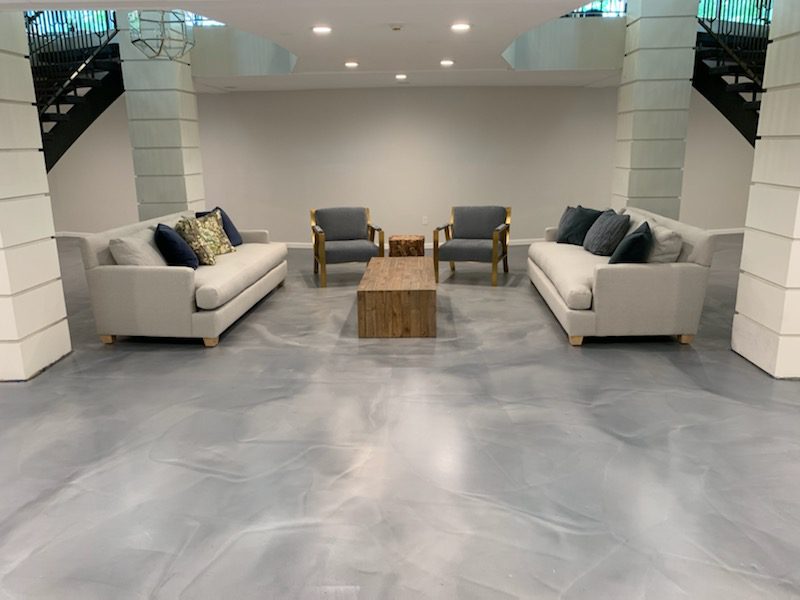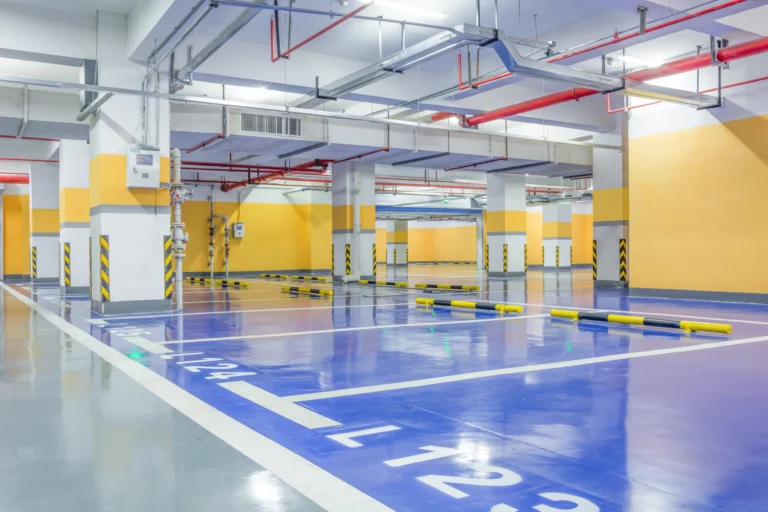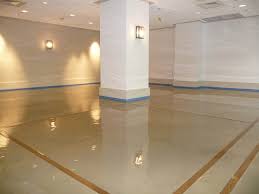Epoxy flooring is a popular choice for many due to its durability and glossy finish. However, like any flooring option, it comes with its own set of drawbacks. Understanding these disadvantages can help you make an informed decision about whether epoxy flooring is the right choice for your space.
Strong Application Fumes
Epoxy flooring emits strong fumes during application, which can be harmful if inhaled. These fumes are primarily due to the volatile organic compounds (VOCs) present in the epoxy resin. It’s crucial to ensure proper ventilation during installation to minimize health risks.
- Health Risks: Inhaling epoxy fumes can cause respiratory issues and skin irritation.
- Ventilation Needs: Adequate ventilation is necessary to disperse fumes and ensure safety.
Long Curing Time
The curing time for epoxy flooring can be quite lengthy, often taking several days to fully harden. This extended period can be inconvenient, especially in high-traffic areas where downtime is costly.
- Extended Downtime: Areas remain unusable during the curing process.
- Temperature Sensitivity: Curing time can vary based on environmental conditions.
Slippery When Wet
Epoxy flooring can become extremely slippery when wet, posing a safety hazard. This is particularly concerning in areas prone to spills or moisture.
- Safety Concerns: Increased risk of slips and falls.
- Surface Treatments: Anti-slip additives can be used to improve traction.
Potential for Peeling and Cracking
Over time, epoxy floors may peel or crack, especially if the surface was not properly prepared before application. This can lead to costly repairs and maintenance.
- Surface Preparation: Proper preparation is crucial to prevent peeling.
- Repair Costs: Cracks and peeling can lead to expensive repairs.
Installation Challenges
Demanding Application Process
The application process for epoxy flooring is complex and requires precision. Any mistakes during installation can lead to long-term issues.
- Skill Requirement: Professional installation is often necessary.
- Time-Consuming: The process can be lengthy and labor-intensive.
Sensitivity to Moisture and Temperature
Epoxy flooring is sensitive to moisture and temperature changes, which can affect its durability and appearance.
- Moisture Issues: Excess moisture can prevent proper adhesion.
- Temperature Fluctuations: Extreme temperatures can cause the epoxy to expand or contract.
Limited DIY-Friendliness
Due to the complexity of the installation process, epoxy flooring is not ideal for DIY projects. Professional installation is recommended to ensure a quality finish.
- Professional Help: Hiring professionals increases costs.
- Complex Process: Requires specialized tools and knowledge.
Maintenance and Repair Issues
Difficulty in Repairing Damaged Areas
Repairing damaged epoxy flooring can be challenging and often requires professional assistance. Matching the color and finish of the existing floor can be difficult.
- Color Matching: Achieving a seamless repair is challenging.
- Professional Repairs: Often necessary for satisfactory results.
Yellowing Over Time
Exposure to sunlight can cause epoxy floors to yellow over time, affecting their aesthetic appeal.
- UV Exposure: Sunlight can lead to discoloration.
- Protective Coatings: UV-resistant coatings can help prevent yellowing.
Susceptibility to UV Damage
Epoxy flooring is susceptible to UV damage, which can degrade the material and affect its appearance.
- Material Degradation: UV rays can weaken the epoxy.
- Preventive Measures: UV-resistant topcoats can mitigate damage.
Cost Considerations
Higher Initial Investment
The initial cost of epoxy flooring can be higher compared to other flooring options. This includes the cost of materials and professional installation.
- Material Costs: High-quality epoxy is expensive.
- Installation Fees: Professional installation adds to the cost.
Professional Installation Expenses
Hiring professionals for installation increases the overall cost of epoxy flooring. However, it ensures a quality finish and reduces the risk of errors.
- Quality Assurance: Professional installation ensures durability.
- Cost Implications: Increases the total project cost.
Long-Term Maintenance Costs
While epoxy flooring is durable, it requires regular maintenance to retain its appearance and functionality. This can add to the long-term costs.
- Regular Maintenance: Necessary to prevent wear and tear.
- Cost of Repairs: Damages can be costly to fix.
Aesthetic Limitations

Limited Design Options
Epoxy flooring offers limited design options compared to other flooring types. This can be a drawback for those seeking a unique or personalized look.
- Design Constraints: Fewer patterns and colors available.
- Customization Limits: Limited ability to personalize the floor.
Industrial Appearance
Epoxy flooring often has an industrial look, which may not suit all residential or commercial spaces.
- Aesthetic Appeal: May not match all interior designs.
- Alternative Options: Other flooring types offer more variety.
Difficulty in Changing Floor Style
Once installed, changing the style of an epoxy floor can be difficult and costly. This limits flexibility in updating the look of a space.
- Permanent Installation: Difficult to alter once applied.
- Costly Changes: Expensive to replace or modify.
Environmental Concerns
VOC Emissions During Application
The application of epoxy flooring releases VOCs, which can contribute to indoor air pollution and environmental harm.
- Air Quality Impact: VOCs can affect indoor air quality.
- Environmental Harm: Contributes to pollution.
Non-Biodegradable Material
Epoxy is a non-biodegradable material, which raises concerns about its environmental impact.
- Waste Concerns: Disposal can be challenging.
- Sustainability Issues: Not an eco-friendly option.
Disposal Challenges
Disposing of epoxy flooring can be difficult due to its non-biodegradable nature and potential environmental impact.
- Disposal Costs: Can be expensive and complex.
- Environmental Regulations: Must comply with disposal laws.
Comparison with Alternative Flooring Options
Epoxy vs. Polished Concrete
Polished concrete offers a similar industrial look to epoxy but with fewer maintenance requirements. It is also more environmentally friendly due to its lower VOC emissions.
| Feature | Epoxy Flooring | Polished Concrete |
| Durability | High | High |
| Maintenance | Moderate | Low |
| Environmental Impact | High | Low |
Epoxy vs. Tile Flooring
Tile flooring provides more design options and is easier to repair than epoxy. However, it may not offer the same level of durability in high-traffic areas.
| Feature | Epoxy Flooring | Tile Flooring |
| Design Options | Limited | Extensive |
| Repairability | Difficult | Easy |
| Durability | High | Moderate |
Epoxy vs. Vinyl Flooring
Vinyl flooring is more affordable and offers a wider range of designs compared to epoxy. However, it may not be as durable in industrial settings.
| Feature | Epoxy Flooring | Vinyl Flooring |
| Cost | High | Low |
| Design Options | Limited | Extensive |
| Durability | High | Moderate |
Specific Application Concerns
Epoxy Flooring in Residential Settings
In residential settings, epoxy flooring can be a durable option for garages and basements. However, its industrial appearance may not suit all home interiors.
- Garage Use: Ideal for garages due to durability.
- Interior Design: May not match all home aesthetics.
Epoxy Flooring in Commercial Spaces
Epoxy flooring is popular in commercial spaces due to its durability and ease of maintenance. However, its installation can disrupt business operations.
- Durability: Suitable for high-traffic areas.
- Installation Disruption: Can affect business operations.
Epoxy Flooring in Industrial Environments
In industrial environments, epoxy flooring is valued for its resistance to chemicals and heavy machinery. However, it requires regular maintenance to prevent wear and tear.
- Chemical Resistance: Ideal for industrial use.
- Maintenance Needs: Regular upkeep is necessary.
Mitigating Epoxy Flooring Disadvantages
Proper Surface Preparation
Ensuring the surface is properly prepared before applying epoxy can prevent many common issues such as peeling and cracking. This involves cleaning, repairing, and priming the surface.
- Cleaning: Remove all dirt and debris.
- Repairing: Fix any cracks or imperfections.
- Priming: Apply a suitable primer for better adhesion.
Professional Installation
Hiring professionals for installation can mitigate many of the challenges associated with epoxy flooring. Professionals have the expertise and tools necessary to ensure a quality finish.
- Expertise: Professionals have the necessary skills.
- Quality Assurance: Ensures a durable and long-lasting finish.
Regular Maintenance
Regular maintenance can extend the lifespan of epoxy flooring and prevent issues such as yellowing and UV damage. This includes cleaning, resealing, and addressing any damage promptly.
- Cleaning: Regularly clean to maintain appearance.
- Resealing: Apply sealants to protect against UV damage.
- Damage Repair: Address any issues promptly to prevent further damage.
Future Trends in Epoxy Flooring
Advancements in Epoxy Technology
Advancements in epoxy technology are leading to more durable and environmentally friendly options. These innovations aim to reduce VOC emissions and improve the overall performance of epoxy flooring.
- Durability Improvements: New formulations offer enhanced durability.
- Eco-Friendly Options: Reduced VOC emissions for better air quality.
Eco-Friendly Epoxy Options
Eco-friendly epoxy options are becoming more popular as consumers seek sustainable flooring solutions. These options use bio-based materials and have lower environmental impacts.
- Sustainable Materials: Use of bio-based resins.
- Reduced Environmental Impact: Lower VOC emissions and improved sustainability.
Improved Application Techniques
Improved application techniques are making epoxy flooring more accessible and reducing installation challenges. These techniques focus on faster curing times and easier application processes.
- Faster Curing: New methods reduce downtime.
- Simplified Application: Easier processes for better results.
Statistical Insights
Epoxy Flooring Market Growth
The epoxy flooring market is experiencing significant growth, driven by demand in industrial and commercial sectors. According to Grand View Research, the market is expected to continue expanding due to its durability and cost-effectiveness.
VOC Emissions in Epoxy Flooring
Epoxy flooring is known for its VOC emissions, which can impact indoor air quality. The Environmental Protection Agency (EPA) highlights the importance of proper ventilation during installation to mitigate these effects.
Slip Resistance Ratings
The Occupational Safety and Health Administration (OSHA) provides guidelines for slip resistance in flooring. Epoxy flooring can be made safer with the addition of anti-slip additives, improving its slip resistance rating.
FAQs
Does epoxy flooring crack easily?
Epoxy flooring can crack if the surface is not properly prepared or if it is exposed to extreme temperature changes. Proper installation and maintenance can help prevent cracking.
Is epoxy flooring slippery when wet?
Yes, epoxy flooring can be slippery when wet, which poses a safety risk. Adding anti-slip additives during installation can help improve traction and reduce the risk of slips and falls.
Can you put epoxy flooring over existing floors?
Epoxy flooring can be applied over existing floors, but the surface must be properly prepared to ensure adhesion. This may involve cleaning, sanding, or repairing the existing floor before application.
What are the disadvantages of epoxy flooring?
Epoxy flooring has several disadvantages, including strong application fumes, long curing times, and a tendency to become slippery when wet. Additionally, it can peel or crack over time, and its installation process is complex and often requires professional help.
How long does epoxy flooring last?
Epoxy flooring can last anywhere from 5 to 10 years, depending on the quality of the installation and the level of maintenance. Regular upkeep and proper care can extend its lifespan.
Is epoxy flooring worth the cost?
Epoxy flooring can be worth the cost for those seeking a durable and long-lasting flooring solution. However, the initial investment and potential maintenance costs should be considered before making a decision.
Can epoxy flooring be removed?
Yes, epoxy flooring can be removed, but the process can be labor-intensive and costly. It often requires professional assistance to ensure the underlying surface is not damaged during removal.
What are the pros and cons of epoxy flooring?
Epoxy flooring offers durability and a glossy finish, making it ideal for industrial and commercial spaces. However, it has drawbacks such as strong fumes, long curing times, and potential for peeling and cracking.
Is epoxy flooring good for homes?
Epoxy flooring can be a good choice for homes, particularly in garages and basements. However, its industrial appearance may not suit all interior designs, and it can be slippery when wet.
How often does epoxy flooring need to be replaced?
Epoxy flooring typically lasts 5 to 10 years, depending on the level of maintenance and the amount of traffic it receives. Regular maintenance can extend its lifespan and delay the need for replacement.





